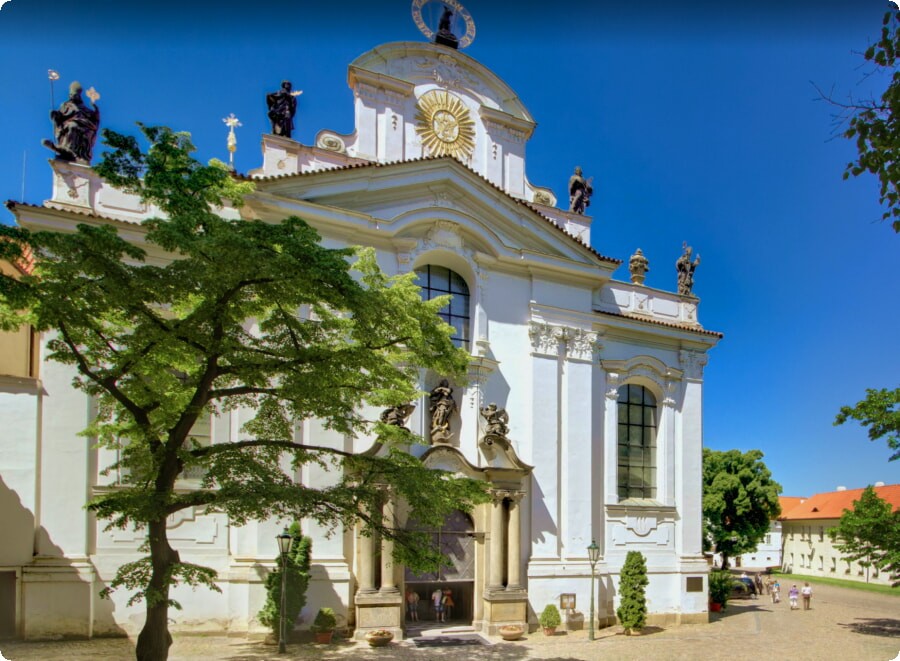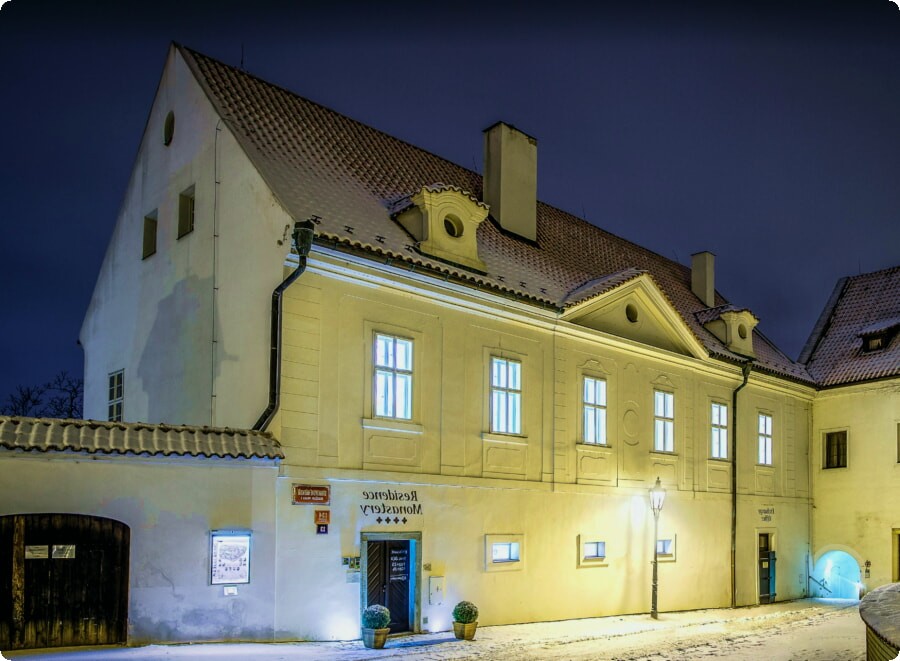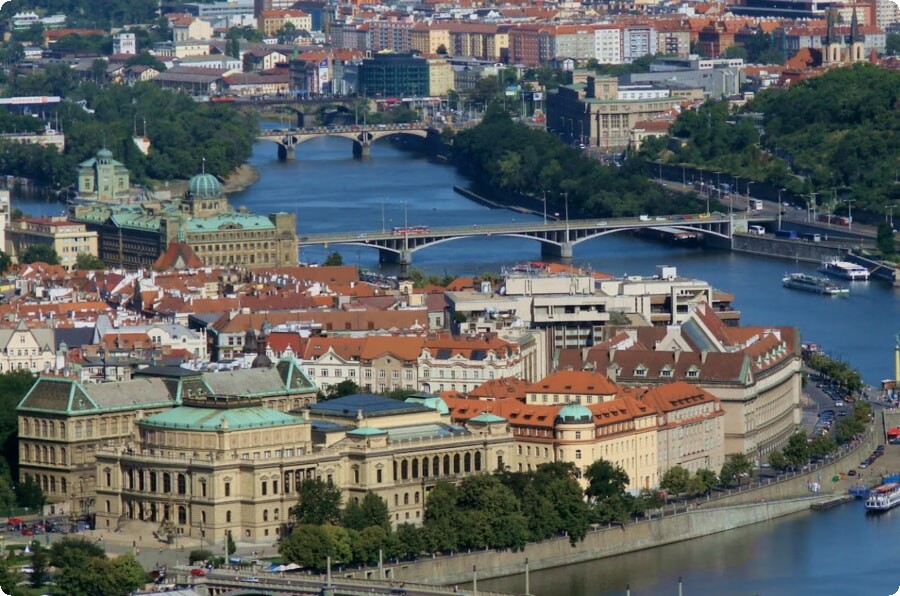The best sights of Prague
Prague is a city of picturesque buildings and streets that could have come straight out of a fairytale. We’ve put together a list of the best sights to visit in this beautiful capital city.
Start your trip with a tour of Prague Castle, one of the world’s largest ancient castles. It takes several hours to explore this massive architectural complex, but it’s worth the effort.
Every day, tourists go to the Czech Republic pre-ordering a car rental. In Prague, the average cost of a compact car is 15 euros per day, in Karlovy Vary - 14 euros per day.
1. Strahov Monastery
Strahov Monastery is a Premonstratensian abbey tucked away on top of Petrin Hill, not far from Prague Castle. It’s not a popular destination for tourists, but it’s worth adding to your itinerary for its panoramic view of the city and tranquil atmosphere.
The monastery was founded in 1143 by Vladislav II, a member of the ruling royal family, and is still home to Premonstratensian monks. Its dormitories and refectory are off-limits to visitors, but the impressive library remains open.
There are two main parts to the library: the theological hall, which is brimming with religious books, and the philosophical hall, a masterpiece of 18th-century Baroque architecture. Both feature exquisite frescoes and opulently decorated bookcases. Geographical and astrological globes also line the walls.
The monastery is home to one of Europe’s most spectacular libraries, with more than 125,000 classic and rare books filling the floor-to-ceiling bookcases in both halls. The Philosophical Hall, with a gorgeous painted ceiling, features works on philosophy, astronomy, history, and math.


2. Charles Bridge
Charles Bridge is one of the most popular attractions in Prague and an absolute must-see during your stay. It’s an impressive 516 meter long gothic bridge made of Bohemian sandstone with 16 arches and three towers.
During the 17th and 18th centuries, it was adorned with around thirty Baroque statues. Most of them are now replica replacements, although the originals are still exhibited in Prague’s museums.
There are two rows of main statues on the north and south sides of the bridge. They represent various saints and patron saints of the city.
Some of the most important are: Statue of St John of Nepomuk, a Czech saint who was thrown into the river after refusing to reveal the confessions of King Wenceslas IV; and St. Luthgard, a blind nun who had a vision that Jesus leant over to kiss her.
Another very popular statue is the one of a knight with a dog, and many tourists pet or rub this one. They think that this will bring them good luck and a return to Prague in the future. However, recent research by a British company suggests that touching these statues can actually lead to bacteria infections.

3. Maltese Square
Prague has been through many incarnations: a historic town that grew up in the Middle Ages, a city struggling under Communist rule and now an innovative, high-end cosmopolitan hotspot. It’s now a sophisticated city that offers visitors world-class art galleries, a vibrant restaurant scene and top-quality nightlife.
Maltese Square is a beautiful place to explore and it’s home to many historical landmarks. At the northern end you can admire a statue of St John the Baptist, part of a fountain that was erected to celebrate the end of a plague epidemic in 1715.
The Church of Our Lady Below the Chain is another iconic building in the square. It dates back to the 13th century and it’s a beautiful example of early Baroque architecture.
To the south of the square, you’ll find three more beautiful baroque buildings that date from the 17th century. These include the Grandmaster’s Palace, which is a spectacular baroque masterpiece that once served as the Knights’ headquarters. It’s now the President’s office and it’s well worth exploring for its beautiful architecture and rich history.

4. Petrin Tower
If you want to get a bird’s-eye view of Prague, Petrin Tower is the place to go. It’s a replica of the Eiffel Tower in Paris, and it can be climbed to the top for a spectacular view of the city.
The Petrin Tower was originally a construction project for the General Land Centennial Exhibition in 1891, and it quickly went from idea to reality. The members of the Czech Tourist Club were inspired by the imposing structure in Paris, and they sought permission to build it in their own country.
In addition to its impressive architecture, the Petrin Tower also provides a beautiful view of the city centre and Vltava River. You can climb up to the observation deck for a small fee and enjoy one of the best views in Prague.
The tower is surrounded by a large park called Petrin Hill, which is covered in swathes of greenery and is a popular spot for Prague locals to relax. It can be reached on foot or by taking the funicular from Ujezd Street.
5. Devil’s Stream
In the Little Quarter of Prague, you will find a delightfully tranquil corner that is the Devil’s Stream. The narrow artificial channel separates Kampa Island from Mala Strana, the Lesser Town. Its name is reputedly to have come from a nasty, spirited lady who washed her dirty laundry in the stream.
The manmade island of Kampa was formed in the 12th century by a narrow canal, dug to power water mills. Today, it’s one of the most picturesque places in Prague and a popular spot for a stroll.
You can enjoy a romantic square under Charles Bridge and then follow your steps to the green Kampa Park, where you’ll find one of Prague’s galleries of modern art. The manmade canal also encloses a museum with a collection of central European artwork.
Next, you’ll walk to the Estates Theater (38), a Neoclassical building whose lime-green and white facade is topped with beautiful sgraffito etchings. This building was once home to a German community and is an iconic example of Neoclassical elegance in Prague.
6. Jewish Cemetery
One of the best sights to visit in Prague is the Old Jewish Cemetery, managed by the city’s Jewish museum. Located in Josefov, the Jewish Quarter, it is home to thousands of tombstones that are crammed into the grounds.
It was established in the 15th century, and was the only place where Jews could bury their dead. During the 300 years it was used, some 100,000 people are believed to have been buried underneath the 12,000 graves that now fill its surface.
The cemetery is higher than its surrounding streets, and the headstones crowd together and lean against each other. Visitors walk the paths reading the inscriptions, mostly in Hebrew, and sometimes leaving a pebble or prayer.
The inscriptions on the stones were written by rabbis with a poetic gift. They drew on the Torah and the Talmud and often portrayed the deceased as a God-fearing person. They also included images and decorative designs.
7. National Museum
If you are a fan of neo-renaissance architecture, the National Museum is a must-see in Prague. It stands out from the rest of the neo-renaissance buildings that line Wenceslas Square by its sheer mass, but it also has one distinctive feature: a central pantheon of statues.
The National Museum, founded in 1818, is a defining monument of Czech nationalism. Initially it specialised in natural sciences, but as time passed, its collections became more diverse and the building itself has served to serve as a symbol of the country’s pride.
The main museum building was heavily damaged during World War II, but it recovered and has since then remained an important landmark of the city. The front facade was also damaged by Soviet machine gun fire in 1968 and during the construction of the Prague Metro, but it has undergone extensive reconstruction work since 2011.
8. Cerny Tower
One of Prague’s most iconic sights is Cerny Tower, a tower that’s shaped like the Czech Republic. It’s a unique tourist attraction that was installed by local artist David Cerny, and it’s definitely something to see if you’re a fan of the arts.
The tower itself is a slender spire, and it offers amazing views over the city. It’s a good place to relax and enjoy the view, or to grab a bite to eat at a nearby restaurant.
But it’s not just the view that attracts tourists to this tower – it’s also the artworks installed by Cerny on top. He’s a well-known Czech artist who combines provocative art with cheeky expression in his work.
For example, one of his most notable installations is called “Brownnosing.” Here, two giant statues depict men bent over with ladders leading to holes in their backsides. Inside, viewers can climb up to the ladders and watch a video that portrays former President Vaclav Klaus and Milan Knizak spoon-feeding each other slop while listening to Queen’s “We Are the Champions.”
Another of his more memorable installations is the “Metamorphosis” in Kampa Park, a giant metal head with moving layers that looks remarkably like a monster. It’s also worth a visit at night when it’s lit up.